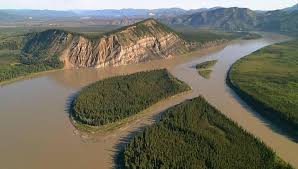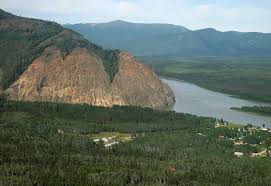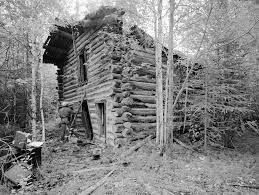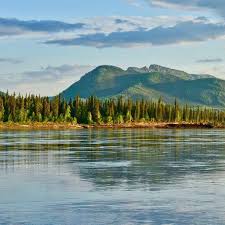Freezer Burned: Tales of Interior Alaska
Posted May 25, 2022 at 6:01 pm by San Juan Update
 Freezer Burned is an ongoing series for the San Juan Update, written by Steve Ulvi. Read the previous story in this series.
Freezer Burned is an ongoing series for the San Juan Update, written by Steve Ulvi. Read the previous story in this series.
A Yukon River Maverick
(This story is creative non-fiction; respectfully embellished where fact and anecdote blur, an informed yet speculative tale. No one knows just what happened during the last days and hours of the active, intentional life of Richard O. Cook. He was a maverick, seamlessly at home on the lower Tatonduk River, and a friend. He was masterfully depicted as an Alaska bush-dwelling character in the 1977 classic, Coming into the Country by John McPhee).
Stooped some, slight of frame with corded muscles, Dick Cook hardly appeared to be 70 years along the path of life. His thinning dark curly hair bloomed at the edge of his sweatshirt hood; eyes steady, wheels turning in his head as always. Cook sipped black tea from a tannin-shellacked cup near the river’s rising edge. Unsurprisingly, his teeth also showed his love of strong tea. Brushing away hovering mosquitos, staring upriver, he pushed his hood back to better assess the clearing sky; his untamed beard and hair looked to be trimmed by a sharp knife, his worn clothes and a hooded sweatshirt always the same.
Cook’s unremarkable log shack tucked on a small forested island at Pass Creek, piled with decades of stuff, had burned and collapsed a couple of years back. A stone’s throw behind where Cook stood, close to the charred pile was his mold-freckled wall tent, elevated cache and strewn camp. A year before, he had loaded his old 4×4 truck with building materials, put it on a raft in Eagle, guided it 27 miles with his canoe, landed at his cabin and motored up the Tatonduk River gravel bars (in violation of many laws, conservation ethics and common sense) for a couple of miles. It still sat on a high bar 4 miles down; unmoving. Cabin rebuilding stalled out. One of his cherished sled dogs, inbred for decades in a prideful Cookian selection process, roamed and barked at red squirrels who chattered teasingly in the grey-green spruce canopy.
 The weeks around summer solstice are often a marathon of labor and re-creation for bush-dwellers. It is an intense period of riotous light when clocks lose meaning. This day, the front peaks up the Tatonduk River (thought to mean “River of Broken Rocks” in Han Athapaskan) were obscured in cloying clouds. Upper drainage rain had swelled the river; flooding braided bars of larger cobble that normally shouldered the flow within the main channels in a readable way. At a pace that a capable riverman could handle.
The weeks around summer solstice are often a marathon of labor and re-creation for bush-dwellers. It is an intense period of riotous light when clocks lose meaning. This day, the front peaks up the Tatonduk River (thought to mean “River of Broken Rocks” in Han Athapaskan) were obscured in cloying clouds. Upper drainage rain had swelled the river; flooding braided bars of larger cobble that normally shouldered the flow within the main channels in a readable way. At a pace that a capable riverman could handle.
Cook knew this stretch of modest river flowing from an impassible slot canyon up in Canada; likely better than anyone with white skin ever had, after hundreds of canoe trips up and down. But at highwater, widening chutes gain velocity and build hydraulic energy that tumbles melon cobble beneath the surface creating a muffled knocking. Inundated willow bars were being scoured while leafy flexible stems bent downstream. Logjams deposited in previous floods strained the racing current.
At that moment, negotiating the half-dozen snaking miles to the Yukon and his summer cabin was chancy. His laying hens, feed grain as well as bags of dried fish, chains, water bowls, assorted gear and mail to go to Eagle, would be lashed low in his dented 19-foot Grumman square stern canoe. His few dogs would eagerly run along the forested bank trail; they often did. It may have seemed absurd, even defeatist, to consider laboring in repeated forest trail trips, hauling everything plus dragging the canoe, rather than make the run.
By June Cook was usually at his lower cabin. Surely it was an invigorating change to be encamped in the heart of the big riverine landscape; revolving slanted light, advancing and receding shadows creating a changing panorama across the green hills. The Big River; the regional thoroughfare, had gone quiet. Countless village sites established over the many thousands of years of occupation and use by Han Athapaskan people had been flooded, overgrown and rendered nearly invisible. Moldering, goldrush-spawned historic sites were ghosting everywhere. In early summer the watery corridor promised the arrival of large fat-laden king salmon, resident fish, ducks, beavers and black bears for dog and man food.
Parts of his slumping historic cabin roof were rotting, sloughing and leaking more with each passing year. Cook saw no good reason for doing the hard work that would just make it more attractive for folks to stop in and use the place. He generally shunned work. In fact, during the winter he sometimes removed the stove pipe in violation of the respected north country rule of leaving a cabin ready for needy travelers; that is downright cranky and unneighborly. Beside this cabin was his precious garden, nourished by years of buried fish offal. A couple gangly fruit trees that he claimed was a “horticultural experiment” never matured edible fruit. Tools, fishing nets and collected usable river flotsam stood ready in disarray.
Watching a circling bald eagle, spitting shreds of tea leaves, his mind would wander ahead; he needed to check his young garden, gather stuff, pick up some fresher gasoline and head up the tawny Yukon. He would motor slackened water along the shorelines and inside sloughs to make 3 or 4 miles per hour, dogs running free. He would have to cross the half-mile wide Yukon twice; loading the dogs, losing some progress each time. A familiar enough journey but not so in the busy time of late June. He had arranged to leave his animals, his companions, with friends who lived a couple of miles below Eagle while he was off in Fairbanks.
 The previous July of 2000, unaware of a last-minute “special action” that strictly limited harvesting king salmon to protect the run, he had set a short gillnet in a marginal, debris swirled eddy he used. It was touted to be one of the worst runs in recent history, yet State of Alaska fishery managers had opened several commercial periods on the lower river while awaiting more test catch data; meanwhile severely limiting subsistence fishing on the entire upper Yukon to a few hours each week. Law enforcement officers flying that section of the river during a closure had spotted his arc of corks, landed the float plane, pulled his net onto the bank and left him a note about the closure. Incensed, Cook had reset the piled net (that might snag one or two salmon a day) and a few days later the net was confiscated and he was cited.
The previous July of 2000, unaware of a last-minute “special action” that strictly limited harvesting king salmon to protect the run, he had set a short gillnet in a marginal, debris swirled eddy he used. It was touted to be one of the worst runs in recent history, yet State of Alaska fishery managers had opened several commercial periods on the lower river while awaiting more test catch data; meanwhile severely limiting subsistence fishing on the entire upper Yukon to a few hours each week. Law enforcement officers flying that section of the river during a closure had spotted his arc of corks, landed the float plane, pulled his net onto the bank and left him a note about the closure. Incensed, Cook had reset the piled net (that might snag one or two salmon a day) and a few days later the net was confiscated and he was cited.
He seethed with righteous indignation and soon made an unusual trip to Eagle to call the federal office listed. Informed that it was a $400 fine Cook decided to make a stand to force the federal side of the fisheries co-management structure to override the State of Alaska and meet its own obligations to provide for a “subsistence priority” based upon traditional and customary use on federal public lands when fisheries had to be restricted. He called Alaska Legal Services for pro bono help. Attorneys sought immediate remedy by contacting federal officials to explain Cook’s lifestyle and utter dependence on king salmon. Unsuccessful, and learning that the impending fall chum salmon run would also be severely restricted, creating serious problems for people who needed to feed working sled dogs, he and his lawyers drew up a lawsuit and filed it in District Court. That pivotal court date was just days away in late June of 2001.
Cook had no means of communication other than to trek to Eagle. His mind was roiling like the river at his feet. After occupying this place for 30 some years, it might seem that exceptional skills, keen situational awareness and countless predicaments resolved could create a form of immunity; like a slick shuffle of “your card” back deep into the deck of potential tragedy. In order to live in the woods, far beyond the end of the road without council of a companion, an individual must make committed decisions. For some hardy souls who preferred solitude, having no safety net at all must be invigorating.
Emerging from boyhood in Ohio, Cook had joined the Marine Corps and was ostensibly busted to private – not once, but twice – after punching superior officers. But he was honorably discharged and collected a small monthly disability check for being wounded in Korea. He was said to have wed a model, had two daughters, undergone a disagreeable divorce, married again, studied at the Colorado School of Mines (where on weekends he employed dynamite to expose geo-crystals to sell), tried real estate sales, a stint in a huge Arizona copper mine and who knows what else. Somewhere along the way, probably in late youth, he became a disciple of “Nessmuk”, George Washington Sears, the canoe tripper author of the iconic Woodcraft and Camping first published in 1884.
Cook found his way to the Eagle area in 1964 with his second wife, Ann. He was said to do some wandering, a bit of remote mineral prospecting, and later may have killed wild game for black market sale in Eagle and Eagle Village. Both spouses may have served stints as mayor in the quiet riverbank town. He accompanied Ann (who attended the University of Alaska – Fairbanks in 1967), lived in a tiny trailer on the outskirts of old Fairbanks for a couple of ensuing winters enduring regular cold snaps in the minus 50s F. Cook may have worked construction to pay bills. For reasons unknown he and Ann split amicably. He was said to prefer aiming to “become a bum”; not a lay around societal dropout, but an accomplished Alaska woodsman with few monetary needs.
Living out on the Tatonduk River by 1970, Cook could not have foreseen that the unbounded frontier of Old Alaska was beginning a stunning metamorphosis. Looming Congressional legislation would finally settle Alaska Native land claims but also open a Pandora’s Box by calling for establishing huge parks and wildlife refuges in the “national interest”; all in order to establish a narrow, contiguous corridor of land upon which to build an 800-mile oil pipeline from the North Slope to a huge spigot at the ice-free Port of Valdez. State of Alaska land selections of 103 million acres, unhurried since statehood in 1959 (politicians were wisely awaiting more detailed mineralization mapping), were rushed into the explosive socio-political partitioning that was to literally divide Alaska and constrain rural and urban hunters differently, causing lasting rancor.
 In the late 1960s the political speculation must have seemed far away and insignificant along the river that had gone lonesome once again; first after the 1898 Klondike Gold Rush surged into Alaska (Eagle swelled to nearly 3,000) and flowed on westward nearly as rapidly; following the abrupt decline of military spending after WWII; then the end of the wood-hungry sternwheeler era in the mid-1950s. Airplanes and a rough summer road into the shriveled-up outpost of 50 souls was the future.
In the late 1960s the political speculation must have seemed far away and insignificant along the river that had gone lonesome once again; first after the 1898 Klondike Gold Rush surged into Alaska (Eagle swelled to nearly 3,000) and flowed on westward nearly as rapidly; following the abrupt decline of military spending after WWII; then the end of the wood-hungry sternwheeler era in the mid-1950s. Airplanes and a rough summer road into the shriveled-up outpost of 50 souls was the future.
Nature was rewilding the abandoned sites of superficial human development and increasing wildlife populations again. Cook would enjoy the poison fruits born of decades of federal wildlife control agents flying around setting out deadly strychnine to collect a bounty on wolves. In addition, there were fur trappers, aerial wolf hunters, and locals thumping wolf pups at their dens. Black and brown bears were often shot on sight. The moose population (and likely the Dall Sheep visible on the cliffs and high meadows of his alpine “backyard”) had grown to provide ready meat. Furbearer populations rebounded. The salmon runs had been heavily commercially harvested for many decades but that effort had shrunk.
Of course, there remained frontier conflicts and disputes on gold claims and elsewhere out on the immense river. Cook was an iconoclast, highly opinionated but seemingly not affiliated or antagonistic socially, low key and liked by most folks in the village and town. He may have been of a libertarian leaning. He obviously savored a good deal of solitude. A couple of women; one during the mid-1970s who wanted to learn traditional ways of tanning hides and sewing garments, the other the mother of a young man who was briefly mentored by Cook; lived with him but soon left certain that he “preferred to live alone”. He owned a little wedge of property up the hill where the highway dropped into Eagle, where he kept his shambles of a trailer and tarped collected stuff that could be of potential use. He spent little time there.
Among a trickling stream of immigrants to the end of the road at Eagle in the late 1970s was an easy-going farmer, hunter and gunsmith who moved his family into Eagle from the outskirts of Fairbanks. He flew a scrappy Piper Super Cub and looked to catch some fur to make ends meet. Being of a Baptist strain the family didn’t mix on Sundays with the influential Bible Chapel crowd but seemed to get on with just about everyone. Trapping areas near town were always staunchly claimed, but a short takeoff and landing aircraft skillfully piloted on skis could get into a lot of places in order to set short traplines in the vast landscape well away from town and the native village.
Some of Cook’s fur trapping area, not worked every winter so that it could rest, was now within the National Preserve on the flats across the Yukon and to the west. After seeing the low flying, identifiable plane and hearing take-offs that raised his hackles and ire, Cook would have run the dogs the few miles, may have fired a few offhand rifle shots, then found the plane’s ski tracks. New snowshoe trails led to sets and steel traps to confiscate. It was rumored that Cook may have strung light steel cable a few inches off the snow at the landing spot but if he did, he never had the vengeful satisfaction of finding a flipped airplane and stranded pilot. Taking a more positive tact, he and a Alaska Legal Services lawyer started to prepare a lawsuit claiming that his subsistence trapping, ongoing for decades, was not being protected by the Park Service.
Cook, like most local residents, was not a supporter of the controversial new Yukon-Charley Rivers National Preserve, set in Congressional concrete in 1980. He distrusted the National Park Service itself; but was not a reactionary, conspiratorial, uninformed zealot like many locals. He was well settled. He was better informed than most; he recognized distinct personal advantages. His cabins were not on public land so he had no worries with restrictive cabin regulations looming. He read and reread the enabling legislation, new regulations and policies as they evolved, and was well aware of the trials and tribulations of others who were in “trespass cabins” and unsure of the future under the baleful glare of the federal government. Cook shared his strong opinions with anyone who would listen.
 After a day or two of wavering Cook may have come to his fateful decision in the wee hours, after a restless dusky night as the upriver clouds dissipated and skies cleared on the Tatonduk. His markers of the water level, larger rocks on the gravel bar upon which he stood, were once again exposed. The noisy waters and his conflicted mind were easing. It was time to load the canoe and have a go.
After a day or two of wavering Cook may have come to his fateful decision in the wee hours, after a restless dusky night as the upriver clouds dissipated and skies cleared on the Tatonduk. His markers of the water level, larger rocks on the gravel bar upon which he stood, were once again exposed. The noisy waters and his conflicted mind were easing. It was time to load the canoe and have a go.
By the time he dragged his canoe to the receding water’s edge and mounted the 6- horse outboard he surely felt enervated again. The uncertainty was evaporating and he knew that he could make the mail plane in Eagle next day. Loaded, he pushed out, bow upstream as usual to let the faster current swing it downriver. The overhead sun bathed everything in an ethereal light. His dogs ran to swim the narrow back channel below the cabin to take the trail on higher ground as he hollered encouragement and settled into the rear seat, throttling up for maneuverability. The load looked good and his laying hens clucked wide-eyed in 5-gallon plastic buckets with breathing holes. Cook must have been intensely focused, but probably smiling for the first time in days.
He steered well away from trouble through the first bends and relaxed a bit. He glimpsed his excited huskies at the top of the conifer clad bank once or twice. A few seconds later the aged motor may have misfired and sputtered. He would have revved the throttle, quickly feathered the choke, but the motor fell silent. There was no time to squeeze the gas bulb or turn around to pull the starter cord. Grabbing his paddle he urgently power-stroked fighting against his own weight in the stern and the dead prop acting like an immovable rudder wanting to swing downriver.
Quickly, the long canoe wallowed broadside, then plowed stern-first into a spruce sweeper, overturning in slow motion. He dove out on the current side and swam gripping the floundered canoe until the back eddy below sucked him in. Cursing in sheer relief and frustration, sucking bleeding broken fingernails, dripping and energized by the adrenaline dump, he worked quickly to unstrap the hens. To his relief they were wet but very alive. He found the bail can and feverishly scooped water after pulling out his rifle and bagged gear.
He would have struggled to pull the canoe from the river, then waded to detach the motor, working to dump the remaining water to drag it higher. Hardly pausing, Cook strode clumsily, breathing hard, putting one foot in front of the other to shoulder through the alders, rifle in hand. He gathered his dogs and wits to gain the trail leading a half mile back to the warm embrace of his tent.
Adrenalin-shot and weary, Cook must have stoked the embers in the woodstove, draped his clothes, dried off and likely settled into his mummy bag to sleep hard. The dogs could range outside. Before noon he woke abruptly in a sweltering wall tent. Sitting up stiffly, he considered the near debacle. He pushed open the canvas flaps to see the dogs lolling nearby in the shade. Finally, the damned river was dropping noticeably.
 Snacking on his favored pinole he reinhabited his dry clothes and slurped another cup of tea. This wasn’t his first canoe swamping on his river; there were many over the years, especially in ascending fast, shallow riffles. Cook was keenly aware that he really had to be on it to paddle the wide, keeled canoe in rushing water. As he picked up a few last things he uncharacteristically dated and penciled a note “dumped the canoe in high water” or some such, and left it on his table.
Snacking on his favored pinole he reinhabited his dry clothes and slurped another cup of tea. This wasn’t his first canoe swamping on his river; there were many over the years, especially in ascending fast, shallow riffles. Cook was keenly aware that he really had to be on it to paddle the wide, keeled canoe in rushing water. As he picked up a few last things he uncharacteristically dated and penciled a note “dumped the canoe in high water” or some such, and left it on his table.
Cook knew that the tools, extra parts and better gas at the lower cabin were his best hope to revive the outboard. Lining the canoe all the way to Eagle with dogs would be a protracted affair. Frustrated, but rejuvenated, he laid the old motor in the bottom near the front thwart, again loaded the fed hens and tied everything in. He had lost a paddle but still had his favorite big blade. With muttered reverence to “Momma”, he would push out kneeling mid-ships to have the most leverage and stability. With skilled feathered strokes, deftly switching sides with timing and strength, he managed to keep the bow straight down the rolling tongues of the main channel drops.
A day later, after Cook failed to arrive, his worried friends motored the few miles up to Eagle to report him overdue and convince the Park Service to initiate a search by air. The troubling news spread quickly in town and foolish conspiracy talk sprouted like mushrooms after a rain. The neighbors soon headed back downriver accompanied by a couple boatloads of would-be rescuers. Among them were some ne’er-do-wells who rarely ventured out of town, but strode the dusty streets packing hog-leg revolvers and bowie knives to pick up mail. Some talked up the notion that the State of Alaska “must have done him”. As the small flotilla landed below the Tatonduk’s mouth, Cook’s dogs greeted them at the lower cabin. They were whiny, agitated and hungry. There was no recent sign of Cook, nor a note.
The motley searchers surely hollered in vain hope as some made their way up the unfamiliar bank while others in hip waders ventured up drying, muddy gravel bars. A couple of buckets and a paddle were seen, then the submerged canoe at a log jam as the NPS contract helicopter flew low and slow up to Pass Creek island to land. A ranger found only the curious note in the tent. Eventually the water cleared and dropped and a lifeless body was seen and retrieved from beneath the jam. Cook was immediately identified by his skull and dagger Marine Corps tattoo.
Later, following the well-attended memorial service in Eagle, his two adult daughters (whom he had not seen or contacted for decades) wanted to see the Tatonduk and Pass Creek where they planned to spread their father’s ashes. The upriver neighbors, lacking the right water craft and whitewater skills but emboldened to please the sisters, agreed to try to take them up to Pass Creek. In a fitting finale in the colorful saga of a Yukon River maverick, they capsized part way up, occupants spluttering and grabbing loose gear, wading to gain opposite banks. They were soaked and hollering to one another, but unhurt. The small box containing the cremated remains of Dick Cook; a man with a clear, unconflicted sense of self, who preferred paths less-trodden and being alone on his river, had floated away.
You can support the San Juan Update by doing business with our loyal advertisers, and by making a one-time contribution or a recurring donation.
Categories: Freezer Burned










No comments yet. Be the first!
By submitting a comment you grant the San Juan Update a perpetual license to reproduce your words and name/web site in attribution. Inappropriate, irrelevant and contentious comments may not be published at an admin's discretion. Your email is used for verification purposes only, it will never be shared.